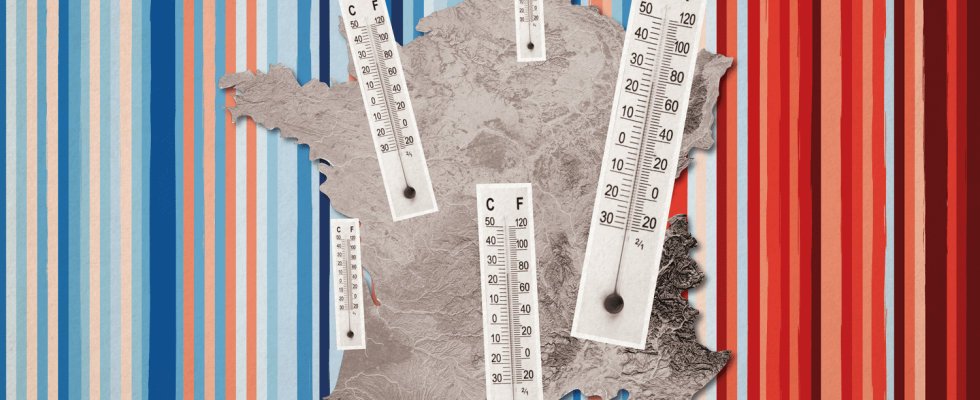MEAN TEMPERATURE Today
DIFFERENCE FROM THE MEAN REFERENCE TEMPERATURE (1971-2000) Today
EVOLUTION OF SPREADS Since 1971
Daily values
Annual evolution
If global warming were a movie, the weather would be one of its scenes. In France, the temperature has already risen by 1.7°C compared to the pre-industrial era (1850-1900), according to the latest calculations by Météo France and the CNRS published in 2022. This phenomenon results from greenhouse gas emissions greenhouse, generated by human activities. And the rise could reach +3.8°C by 2100, in the case of a so-called “moderate” scenario, which corresponds to current public policies.
To put the daily weather forecast in this context of a climate that changes quickly and strongly, franceinfo offers you a new dashboard, updated in collaboration with Météo France. Every day, you can consult the difference between the average temperature in mainland France and that of the period 1971-2000*. This national indicator is calculated using official references established by Météo France from 30 stations representative of the climate in France and Corsica.
Deviations from the average today in 30 stations in mainland France
Scroll the table to explore the 30 stations measured
A warming climate is characterized by an excess of abnormally hot days and a deficit of abnormally cold days. Now, a large majority of days are warmer, even much warmer, than those observed in France just one or two generations ago. Over the past ten years, temperatures have been warmer two-thirds of the time (244 days out of 365 on average). The year 2022 constitutes a record, with more than 80% of days warmer than the reference temperatures over the period 1971-2000. Franceinfo offers you to view this increasingly frequent phenomenon over the last 365 days.
Deviations from average daily temperatures for one year, in metropolitan France
● Hotter
● Colder
In recent decades, temperature differences have increased in our country. This is shown by the “warming stripes”, these graphs in colored bands, developed by the English climatologist Ed Hawkins, and which franceinfo has adapted for France. In blue, are represented the colder years than the reference 1971-2000; in red, the warmer years. The timeline from 1971 to 2022 clearly shows a warming climate nationally and in all regions. Enough to take a more enlightened – but also more alarming – look at the weather forecast that we consult every day.
Evolution of deviations from average annual temperatures since 1971, in metropolitan France
Scroll the table to explore the 30 stations measured
*Methodology
Why did you choose the period 1971-2000 as the reference period for calculating temperature differences?
To gauge temperature fluctuations, climatologists and meteorologists compare them to reference averages. These averages are commonly called “seasonal normals” and correspond to statistics calculated over periods traditionally of thirty years. The choice was made to retain the period 1971-2000, because it is a period during which human influence on the climate has already begun but could still be “masked” by spontaneous climate fluctuations. It is from the 2000s that the effects of human influence are revealed everywhere and in all seasons.
How were the displayed temperatures measured?
Today’s values, updated daily, are based on forecasts made the day before by Météo France. This use of predicted temperatures may imply differences with the average temperatures actually measured a posteriori. But these are low enough to be able to rely on the forecasts.
What are the 30 stations represented on the map of France?
These are the stations used by Météo France to calculate the average temperature in mainland France (also called the national thermal indicator). They are distributed evenly to reflect the climate of France and Corsica. However, the daily temperature of a station cannot be generalized to the region around it. Furthermore, this sample does not include the overseas territories, which have their own particularities (tropical, polar climates, etc.).
Why don’t the temperatures have the same colors on all the graphs?
The colorimetric scale of the graphs varies according to the data they represent, in order to make it possible to distinguish the values by taking into account their distribution and the amplitude of their variations. The location can also be taken into account: thus in the case of “warming stripes”, the interval in degrees of the color palette – from blue to red – is specific to each station.
